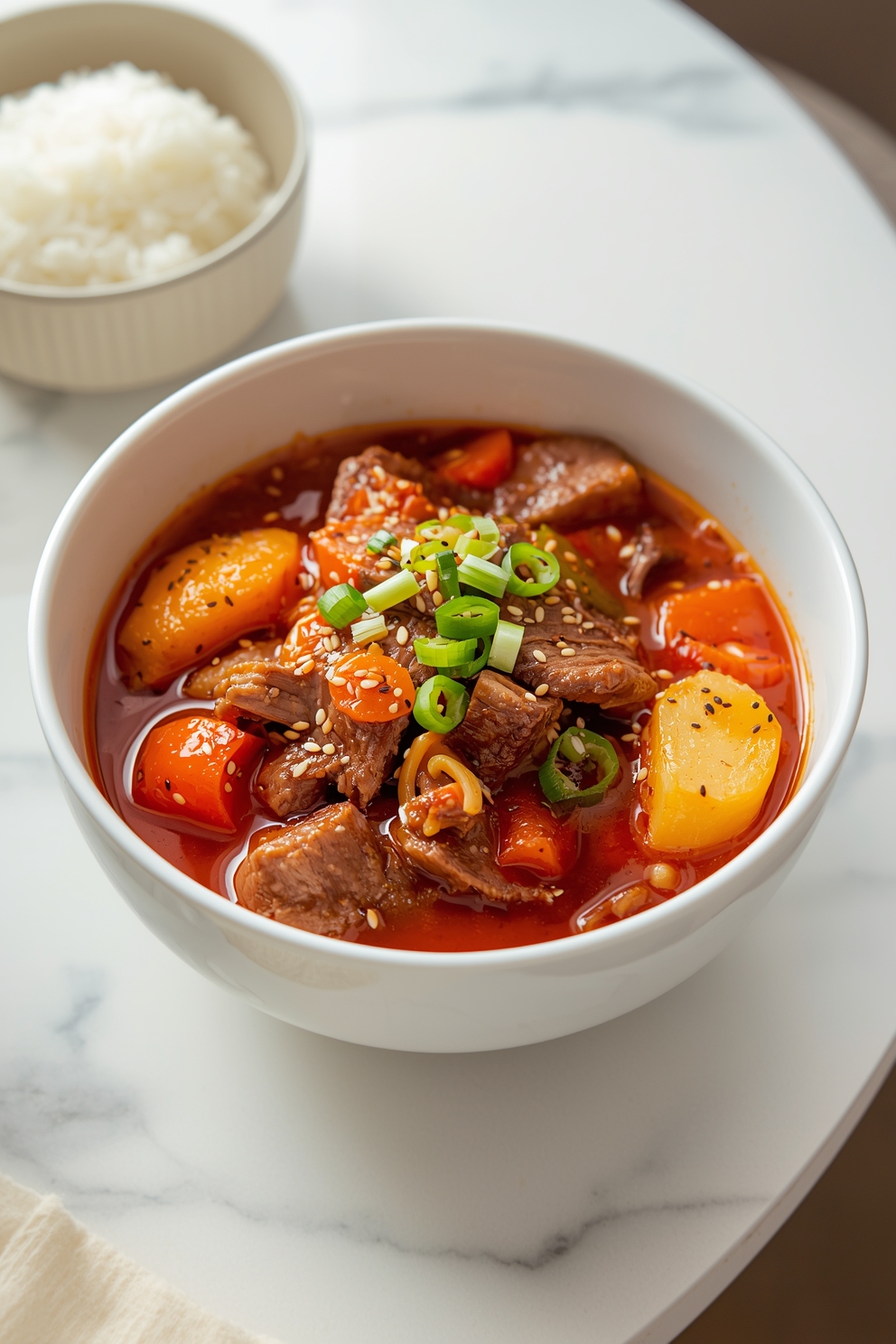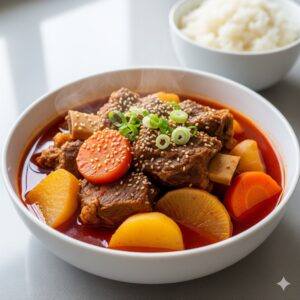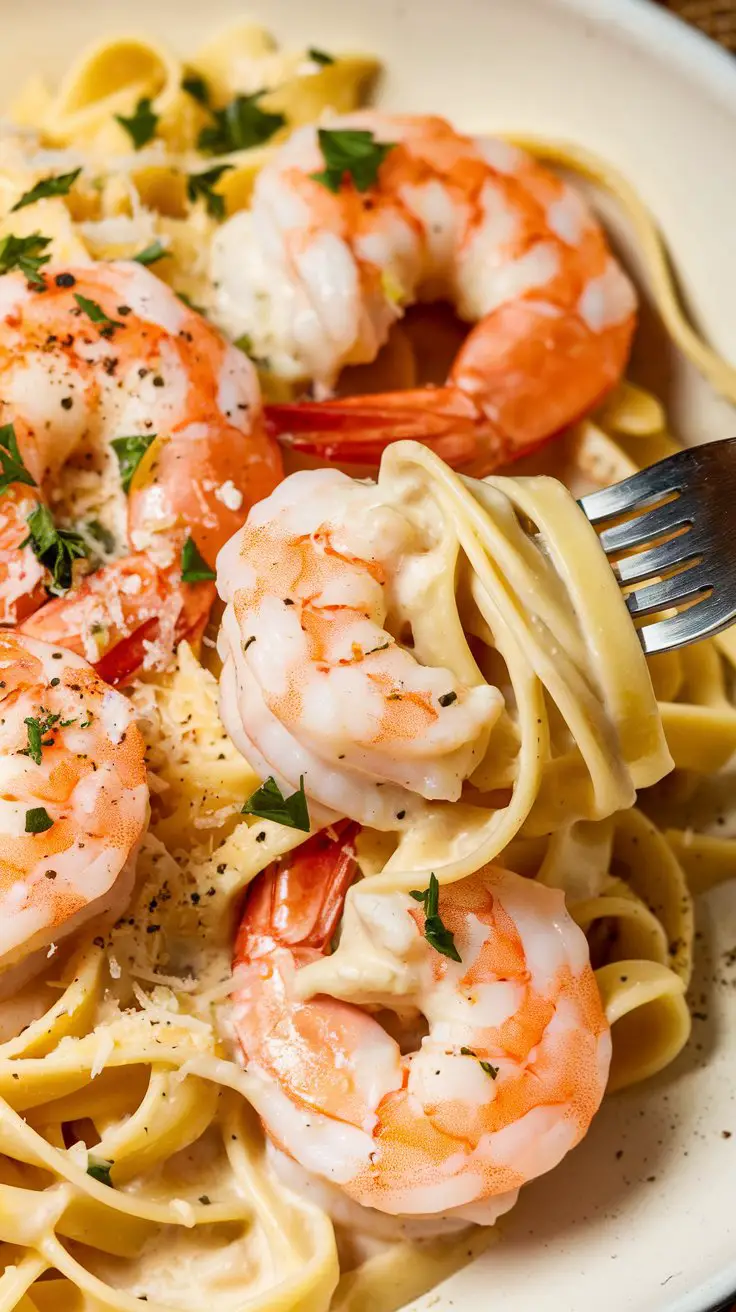Spicy Korean Beef Stew (Galbi Jjim): A Bold & Comforting One-Pot Classic
Tender beef short ribs simmer in a rich, spicy-sweet broth with vegetables until melt-in-your-mouth perfection. This Korean favorite is hearty, comforting, and full of bold flavors that make every bite unforgettable.
Galbi Jjim (갈비찜), meaning “braised short ribs,” is a traditional Korean dish often enjoyed during celebrations, holidays, and family gatherings.

While the classic version is sweet and savory, this spicy variation adds a fiery kick with gochugaru (Korean chili flakes) and gochujang (fermented chili paste), creating a stew that’s both deeply comforting and excitingly bold.
Why You’ll Love This Recipe
- Melt-in-Your-Mouth Beef – Short ribs become incredibly tender after slow braising.
- Bold Flavors – A perfect balance of spicy, sweet, and savory notes.
- Comfort Food with a Kick – Hearty like classic beef stew but with Korean flair.
- Customizable Heat – Adjust spice levels to suit your taste.
- Perfect for Sharing – A dish meant to gather friends and family around the table.

Spicy Korean Beef Stew (Galbi Jjim)
Ingredients
- 3 pounds beef short ribs bone-in, cut into chunks
- Alternative: Beef chuck or oxtail can also be used.
- 2 tablespoons sesame oil
- 1 large onion sliced
- 4 cloves garlic minced
- 1- inch piece ginger grated (about 1 tablespoon)
- 2 medium carrots cut into large chunks
- 2 medium potatoes cut into chunks
- 1 cup daikon radish cut into chunks (optional but traditional)
- 4 cups beef stock or water
- 3 tablespoons soy sauce
- 2 tablespoons gochujang Korean chili paste
- Substitute: Mix miso paste with chili sauce if unavailable.
- 1 tablespoon gochugaru Korean chili flakes
- Adjust for spice preference.
- 2 tablespoons brown sugar or honey
- 2 tablespoons rice wine mirin or soju
- Optional: Adds depth but you can omit.
- 2 green onions cut into 2-inch pieces
- 1 tablespoon toasted sesame seeds for garnish
- Fresh cilantro or extra green onions for garnish (optional)
Instructions
- Prep the Short Ribs
- Rinse the short ribs under cold water to remove bone fragments.
- Optional: Parboil ribs in boiling water for 5 minutes to remove excess fat and impurities. Drain and rinse.
- Tip: This step makes the broth cleaner and less greasy.
- Sauté Aromatics
- Heat sesame oil in a large Dutch oven or heavy pot over medium heat.
- Add onion, garlic, and ginger. Cook for 2–3 minutes, stirring, until fragrant and softened.
- Brown the Short Ribs
- Add short ribs to the pot. Sear on all sides for 6–8 minutes, until golden brown.
- This step deepens the flavor of the stew.
- Build the Broth
- Stir in soy sauce, gochujang, gochugaru, and brown sugar.
- Cook for 1–2 minutes, letting the sauce coat the ribs and become aromatic.
- Simmer Until Tender
- Pour in beef stock and rice wine. Bring to a boil, then reduce heat to low.
- Cover and simmer gently for 1 ½ to 2 hours, stirring occasionally, until ribs are fork-tender.
- Add Vegetables
- Add carrots, potatoes, and daikon radish (if using).
- Simmer uncovered for another 30–40 minutes, until vegetables are tender and broth has slightly thickened.
- Finish & Garnish
- Stir in green onions in the last 5 minutes of cooking.
- Taste and adjust seasoning (add more soy for saltiness, sugar for sweetness, or gochugaru for heat).
- Garnish with sesame seeds and fresh herbs.
- Serve Hot
- Ladle into bowls and serve with steamed white rice or Korean side dishes (banchan).
- Cue: The stew should be richly red, aromatic, and glossy, with tender beef that nearly falls off the bone.
Pro Tips & Variations
- Adjust the Heat – Use less gochugaru and more soy sauce if you prefer mild flavors, or add extra gochujang for a fiery punch.
- Sweetness Balance – Swap brown sugar for honey, pear puree, or apple for a more traditional Korean sweetness.
- Vegetarian Twist – Replace beef with firm tofu or mushrooms, and use vegetable broth instead of beef stock.
- Extra Depth – Add a splash of fish sauce or oyster sauce for umami richness.
- Rice Cooker/Instant Pot Option – Cook on high pressure for 35 minutes, then add vegetables and cook an additional 10 minutes.
Storage & Reheating Tips:
- Store cooled stew in an airtight container in the fridge for up to 4 days.
- Reheat gently on the stovetop over medium-low heat, adding a splash of stock or water if it thickens too much.
- Freeze in portioned containers for up to 2 months. Thaw overnight in the fridge and reheat before serving.
Serving Suggestions
- Traditional Pairings: Serve with steamed white rice, kimchi, and a selection of Korean side dishes (banchan) like pickled radish or seasoned spinach.
- Modern Twist: Spoon over mashed potatoes or egg noodles for a fusion-style comfort dish.
- Drinks: Pair with a cold lager, soju, or a light red wine like Pinot Noir.
- Occasions:
- Weeknight Dinner: A cozy yet exciting family meal.
- Meal Prep: Tastes even better the next day as the flavors deepen.
- Special Gathering: A show-stopping dish for holidays like Lunar New Year or dinner parties with friends.
Frequently Asked Questions
Can I make Galbi Jjim ahead of time?
Yes! The flavors actually improve when made a day in advance. Store in the fridge and gently reheat before serving.
Do I need short ribs, or can I use another cut?
Short ribs are traditional, but beef chuck or brisket also work well if you want a more budget-friendly option.
Is it very spicy?
You control the spice level. Reduce gochugaru for mild heat or omit entirely for a sweeter, family-friendly version.
Can I freeze it?
Yes, this stew freezes beautifully. Just cool completely, store in airtight containers, and freeze for up to 2 months.
What’s the best way to serve it?
With steamed rice and kimchi—it balances the richness and spice perfectly.



